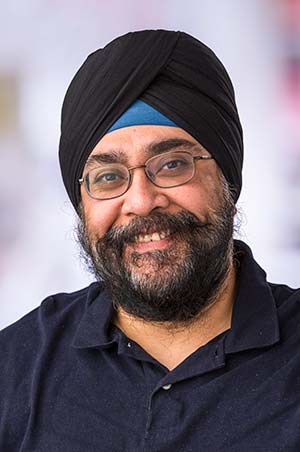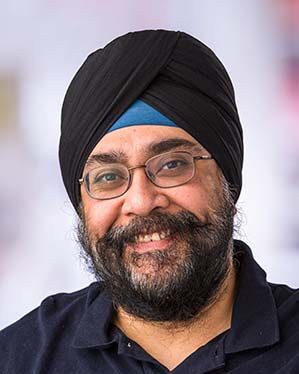
Harmit Malik loves conflict—genetic conflict, that is. “I’m really interested in this idea that components of the same genome, or components of different genomes, are constantly doing battle with each other,” says Malik, who heads a lab at the Fred Hutchinson Cancer Research Center.
To understand genetic conflict, Malik focuses on the parts of the genome that are rapidly changing and evolving. By studying these tumultuous regions, Malik has made impactful discoveries, some of which have overturned the conventional wisdom in genetics that the most important elements of the genome are protected from rapid mutation.
For his contributions, Harmit Malik has been awarded the 2022 Edward Novitski Prize, which recognizes an extraordinary level of creativity and intellectual ingenuity in the solution of significant problems in genetics research.
Breaking evolution’s “speed limit”
Some genes evolve quickly, while others haven’t changed much throughout evolutionary history. Immune system genes, for instance, evolve fast to keep up with the relentless onslaught of different pathogens that they need to fight. For these genes, agility provides the organism with a selective advantage.
On the other hand, genes and proteins that are needed for fundamental cellular functions, like mitosis and meiosis, are expected to evolve much more slowly. Mutations in these genes would be detrimental to the organism’s fitness, presumably, and therefore kept to a minimum. It turns out that this isn’t always the case, however. During his postdoc, Malik made the astonishing discovery that centromeres, among the most essential structures in the cell, undergo unexpectedly rapid evolution.
Centromeres are the constricted regions that give chromosomes their “belted” appearance. They ensure that during cell division, both daughter cells inherit a full and correct set of chromosomes. Centromeric DNA is highly repetitive and does not encode genes, and centromeric histones are proteins that bind to these DNA repeats.
“Centromeric DNA, base pair for base pair, is actually one of the fastest evolving components of our genome,” he says, and centromeric proteins also showed a similarly rapid mutation rate. In fact, the researchers found that mutations arise in these regions faster than the random mutation rate would predict, implying an evolutionary pressure driving the rapid change. At the time, this was “a completely heretical idea, and one of the very first instances where an essential gene had been evolving under what we refer to as positive selection—this idea of faster than expected evolution,” Malik says.
Intrigued, he set out to find what was driving the rapid evolution of centromeric DNA and proteins. During the process of egg formation, four haploid daughter cells are formed, but only one gets selected to be the egg and the other three are destroyed. “We realized this actually introduced an incredible degree of competition as to which chromosomal variant was going to be inherited as the egg chromosome,” says Malik. This competition set the stage for “selfish” genetic variants to arise. A mutation in the centromeric DNA or proteins that increased the chance of being passed down to the egg would have a selective advantage.
Still, something didn’t add up. “It was actually against the best interests of the genome to have this selfish behavior,” says Malik. If centromeric DNA and proteins evolved together, each boosting the other’s inheritance rate, the selfish elements would quickly take over the population and reduce the genetic diversity of the offspring. “We then realized that, actually, they were probably working in conflict with each other,” Malik says. Malik and his postdoc mentor, Steve Henikoff, proposed the “centromere drive model,” which explains the rapid co-evolution of centromeric proteins and DNA as an effect of genetic conflict. While selfish centromeric DNA evolves to increase its chance of being passed down, the centromeric proteins were evolving to suppress this inequity and increase the random chance of any chromosome surviving to the next generation. “The entire centromere drive hypothesis came about to reconcile how something so fundamental to our cell division process could be subjected to the kind of innovation that we see in the host-pathogen interaction,” Malik explains.
Beyond the centromere
While Malik’s work has uncovered a tremendous amount about the evolution of the centromere, his interest in genetic conflicts has taken him into other uncharted research waters. “I think what most of us do is pick a topic that we’re interested in and then try to figure out how to address it,” says Sue Biggins, director of the Basic Sciences Division at Fred Hutchinson. “He has this opposite way of doing it, which is to say if something’s rapidly evolving, something super interesting is happening. He has this fascinating way of using rapid evolution to open up the questions for him. To me, that is the hallmark of someone really creative.”
For instance, Malik helped pioneer the field of paleovirology, studying the traces of viral genes left behind in host genomes over the course of evolution. Viruses are constantly mutating and evolving, and, correspondingly, defenses arise in the genomes of host organisms to combat them. By studying the DNA evidence of this evolutionary arms race, Malik and others hope to glean information about viral defense strategies that could someday be translated into antiviral therapies.
Malik’s creative enthusiasm makes him invaluable as a mentor and colleague. “Talking science with Harmit is invigorating and joyful, in part because of his openness, his authenticity, and his humility,” says Mia Levine of the University of Pennsylvania, who nominated Malik for the award. “He is a perpetual student, making these conversations feel like one of collaborative discovery. These interactions help you see the gold that you are sitting on and give you the confidence to tell the world about it.”
Creative ideas that challenge existing paradigms often run into resistance from the community, and it can take courage to swim against the current. Malik says that he draws on the fearlessness he learned from his mentors to convey that sense of daring to his early career scientists while also providing honest feedback. “My mentor was super supportive, and he really wanted us to not be afraid of being wrong,” he says. “I’m trying very hard to do the same thing. I want people to recognize that science is not a zero-sum game, that it’s actually possible for you to be successful and yet be a really good colleague.”
The Edward Novitski Prize recognizes an extraordinary level of creativity and intellectual ingenuity in the solution of significant problems in genetics research. The prize honors solid, significant, scientific experimental work—either a single experimental accomplishment or a body of work.































